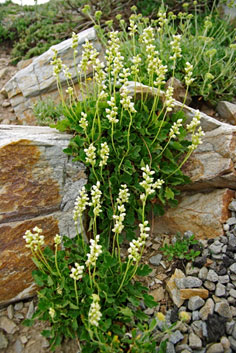Roundleaf Alumroot in the Landscape

Stephen Love, University of Idaho
Scientfic Name: Heuchera cylindricaCommon Name: Roundleaf Alumroot
Description: Roundleaf alumroot is an herbaceous, very long-lived perennial. The plants die back to the ground during winter and new shoots emerge from a cluster of fleshy crowns each spring. In early spring, a small clump of light green, slightly lobed leaves develop. Numerous stiff, unbranched, upright flowering stems emerge a short time later and produce white flowers at the stem tips. Bloom period is three to four weeks, usually in June. The plants may rebloom later in the season, especially if the spent flowers are removed. The foliage remains attractive throughout the summer. Unlike many of the heuchera species, roundleaf alumroot prefers full sun conditions, but will also tolerate varying degrees of shade. This species is a good subject for rock gardens or small borders.
Native Habitat: Roundleaf alumroot is native to the northern Rocky Mountain states, Nevada, and California. Its primary habitat is seasonally dry rocky slopes, rock outcrops, and cliffs. It generally grows with small forbs and clump grasses at elevations ranging from 1,400 to 10,500 feet.
Cultural Requirement
Soil: Adapted to a range of soils, including those with high pH. Does well in heavier soil with higher moisture-holding capacities but can also thrive in well-drained sandy or gravelly substrates.
Moisture Tolerance: In spite of its heritage, this species can survive and bloom in moderately xeric conditions. However, it grows larger, blooms longer and more profusely, and remains more attractive, if given moderate amounts supplemental irrigation.
Sun/Shade/Preference: Thrives in a range of light exposures from full sun to part-shade.
Transplanting: Transplants well, both from pot to pot and from pot to garden. Plants develop rapidly and do well in pots of any common size.
Propagation: Can be grown from seed, although germination rates can be low. Seed requires a long period of cold stratification (12 weeks or more) for best germination. The seeds also require light to germinate and therefore should be planted shallow. Roundleaf alumroot can be easily propagated using crown cuttings or crown divisions.
Maintenance (pruning, fertilization, deadheading, division, irrigation, etc): Remove the flowering stems at the end of spring bloom. Provide consistent supplemental irrigation (every 10 to 15 days during the hottest part of the summer) to prolong bloom and extend the attractive stages of foliage growth. Infrequent fertilization is needed, as plants demand.
Insect, disease, or other problems: Roundleaf alumroot has no serious pests or diseases.
Landscape Value
Use in the Landscape: Roundleaf alumroot is fairly small plant with stiffly upright flowering stems. Its white flowers and neutral leaf color makes it easy to combine with almost any other plant materials. It is a great plant for formal designs, but does not look out of place in naturalized designs. This species can be incorporated almost anywhere, if not planted among tall or aggressive plants, and if given supplemental moisture.
Foliage: The leafy stems are very compact, creating a dense mound of foliage. The leaves are slightly hairy, light green in color, round in shape, and have lobed edges.
Timing: June
Color: White, cream, or greenish-white.
Fruit: The fruit is a dry, papery capsule and contains numerous tiny seeds.
Form: Mounded in the foliar phase, upright and vertical in bloom.
Texture: Moderately fine.
Ultimate Size: Out of bloom - 4 to 8 inches tall; in-bloom plant height varies by provenance but usually in the range of 8 to 24 inches, although occasionally taller.
Rate of Growth: Plants develop slowly when first emerged, then more rapidly as they gain size. They usually do not bloom the first year.
Suggested Plant Partners: Roundleaf alumroot combines well with numerous small grasses and wildflowers with similar water needs. Some good choices include: Penstemon pinifolius, Penstemon humilis, Antennaria rosea, Erigeron glaucus, Erigeron compositus, Campanula rotundifolia, Eriogonum ovalifolium, Fragaria virginiana, and Festuca idahoensis. This species can also be effective when placed around the base of native trees and shrubs.
Availability: Somewhat difficult to find but this choice plant is occasionally available as a potted plant at local or mail order native plant nurseries. Seed can sometimes be purchased from native plant seed suppliers.
Cultivars: None.
References:

